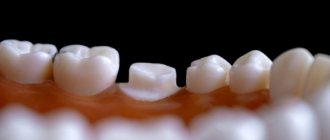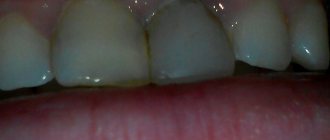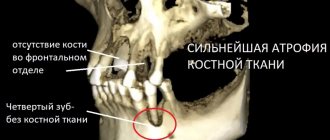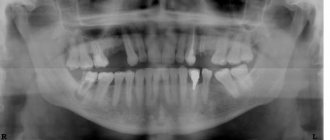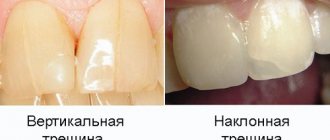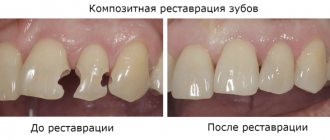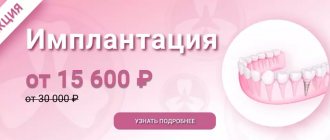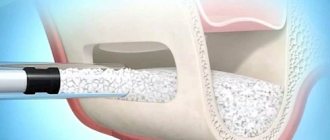Mechanical damage to a tooth due to injury without violating its integrity is called a bruise. This type of injury is common in children and adults, especially athletes. According to statistics, among all injuries to primary teeth, bruises account for 2.5%; bruises of permanent teeth account for 1.5% of the total number of traumatic injuries in the permanent dentition.
Even if the tooth looks unchanged after a bruise, it is necessary to visit a dentist to prevent the development of complications associated with the injury.
Symptoms
A strong blow to a tooth is accompanied by damage to periodontal tissue, and some fibers and small blood vessels rupture. There are no visible structural damage to the tooth; upon visual inspection, it appears intact. After a bruise, the tooth remains motionless, and minor mobility is rarely observed. The gums in the area of the injured tooth swell.
In the first hours after the impact, patients experience pain in the tooth, which intensifies when biting; the pain is aching in nature. The tooth feels high, and slight bleeding may occur from under the gum near it. When a bruise occurs, the neurovascular bundle of the tooth can be damaged, that is, the pulp is injured, and hemorrhage occurs in the pulp chamber, and the enamel becomes pink in color. A severe bruise can lead to the death of the pulp.
Often, when a bruise occurs, cracks appear on the tooth enamel, which can only be detected with a special examination.
What actions should be taken if a child suffers an injury to a baby tooth?
Let's start with the fact that injury is always pain. It would seem that baby teeth will change anyway... Why pay attention to them? Believe me, it is necessary and necessary to pay attention. If you do not contact pediatric dentistry for treatment of baby teeth, then in the future there is a risk that the infection that has affected the baby tooth will damage the germ of the permanent tooth. If you do not pay attention to the injury of a baby tooth, you may not see the damage in the bud of a permanent one.
Children, by nature, have very mobile and active behavior and lifestyle. This is wonderful! But sometimes they do not hear or perceive the warnings of adults aimed at ensuring safety. This leads to various injuries, often associated with teeth. When the question concerns the injury of a baby tooth, you can often treat the moment negligently with the expectation that it is still temporary and would have fallen out anyway.
Don't leave the situation to chance! Even if the injury affected a baby tooth, which was about to fall out anyway. The fact is that the force of a blow is sometimes impossible to estimate. Under the milk tooth is the germ of a permanent one. It is often impossible to conduct even a visual inspection on your own, not to mention what kind of trauma was caused to the gum and, possibly, the germ of a permanent tooth.
In a situation where there is an injury to a child’s tooth(s):
- Stay calm (although this is sometimes difficult in practice). If you are nervous, children will absolutely sense the mood, especially of loved ones.
- Do not scold your child under any circumstances (“I told you, I warned you!”) Do not forget that he is already in pain and scared. All educational moments and lessons from the situation can be raised later, after the pain has calmed down.
- Show maximum care and tenderness, reassure as much as possible.
- It is imperative to visit a dentist for an examination and consultation and conduct a diagnosis of dental treatment. When you call your clinic or the nearest one (at your discretion), DO NOT ask if a pediatrician is working today, DO NOT say that you need a pediatric dentist. It must be said directly that the child has suffered a tooth injury and needs an urgent examination by a doctor. In every decent clinic they should offer you to come right away, regardless of the doctor’s appointment, and they may warn you that you will have to wait. Or, at a minimum, they are obliged to offer: “wait, I’ll clarify what we can do for you, leave your contact phone number and we will call you back in the next 5-20 minutes.” In this case, they will offer to drive to the clinic or direct you where you can go directly at this moment. If they immediately answer you: “We’re all busy, we can’t help you,” don’t ever go to this clinic.
What the doctor will do at the appointment:
- Visually examine how serious or minor the injury is.
- Be sure to take a photo in the area of the injured tooth(s) to understand whether the permanent tooth(s) are damaged or not.
- He will remove the injured tooth so that it does not cause pain and inconvenience. If the blow was not severe and the tooth was only chipped, if recovery is possible, the pediatric dentist will cure it.
- If necessary, provide recommendations for care in the area of injury.
- As planned, he will make an appointment for the child to be examined by a pediatric dentist if it was not possible to get to him on the day of the injury.
Any experienced dentist will be able to visually and with the help of X-ray diagnostics assess how serious the injury is or whether everything was just a minor fright. Don't leave injuries unattended!
Diagnostics
- Patients with a tooth injury are referred for x-ray diagnostics to exclude a root fracture. To obtain information using targeted radiography, it is sometimes necessary to take several images from different angles, which is undesirable for the patient.
The most accurate information about the condition of the roots is provided by computed tomography - an x-ray examination method that allows you to obtain a three-dimensional image of the tooth. The examination results are displayed on the computer screen and must be transferred to a CD or USB flash drive.
An X-ray examination of a tooth bruise reveals a slight widening of the periodontal fissure.
- The condition of the pulp after injury is monitored using EDI - electroodontodiagnosis. The method consists in determining the reaction of the nerve endings of the pulp to the influence of electric current. The level of electrical excitability of the pulp depends not only on its condition, but also on the degree of formation of the tooth root.
The examination is carried out 2 or 3 days after the injury, since on the first day the pulpal response may be reduced due to traumatic neuritis. Be sure to perform an electrical test on adjacent healthy teeth to compare sensitivity levels. 3-4 weeks after the injury, EDI is repeated.
- Another method of examination for a tooth bruise is transillumination, the essence of which is to pass a beam of cold light through the tooth and evaluate shadow formation. If there are cracks in the enamel after an impact, they will be clearly visible in the stream of light; The technique also helps to detect pulpitis. In modern clinics, all dental units are equipped with light guides for transillumination examination.
IF A CHILD HAS KNOCKED OUT A PERMANENT TOOTH
- The tooth must be found, lifted from the ground, rinsed under cool running water for 10 seconds, holding it by the crown - do not rub or touch the root.
- Insert into place as soon as possible. Don’t be embarrassed that if it protrudes a little, the dentist will correct it as needed. Bite on a handkerchief for better fixation of the tooth.
- If a child or parent is afraid to put the tooth in its place themselves, place the tooth in cow's milk, saline (BUT NOT WATER!!!!) (they also recommend placing the tooth in the mouth of an older child, but how realistic is this - it seems to me unrealistic) and very quickly go to the dentist for a replantation procedure. The child needs to hold the tooth in its natural position with a finger (if there is no fixation by biting, use a handkerchief), and the father should try to drive quickly and carefully, without jerking or braking.
Complications after injury
With bruises, the prognosis is usually favorable, but in some cases the injury can lead to the following complications:
- Darkening of the enamel. After a bruise, the cause of darkening is hemorrhage into the pulp chamber: the pink color of the tooth darkens over time, the enamel acquires a brownish or gray tint. Depulped teeth tend to darken due to the fact that metabolic processes in them stop, the teeth become “dead”, and the enamel becomes dull.
- The death of the pulp leads to the development of pulpitis: the pulp decomposes, inflammation develops in the tooth, which without treatment turns into periodontitis.
- Periodontitis is inflammation of periodontal tissue. It can be: post-traumatic, occurring a short time after the injury; chronic, develop as a consequence of pulpitis. When a purulent infection occurs, there is a high risk of tooth loss and purulent blood poisoning.
- The appearance of a post-traumatic odontogenic cyst at the root apex during the development of post-traumatic periodontitis.
- Stopping the development of roots of permanent teeth in children.
- In case of injury to milk teeth, the following are possible: disruption of the formation of the rudiments of permanent teeth, their death.
What to do if your child has a tooth injury
An injury to a child's front tooth requires immediate attention to a dentist. The sooner you go to the doctor, the sooner your baby will receive adequate treatment. Speed of circulation is very important when it comes to preserving dental pulp. To do this, you need to see a doctor no later than two hours after the injury.
When visiting a French dental clinic, our doctors will provide first aid to the child, assess the degree and type of injury and advise you on further actions. Experienced European dentists use all their knowledge and experience to preserve a damaged tooth, restore its health and aesthetic appeal, and also provide acceptable conditions for the development of its root and the formation of a correct bite.
Treatment
- For mild bruises, treatment consists of resting the tooth for 3-4 weeks by reducing the load during chewing: the menu includes soft and semi-liquid foods, and a blender is used to grind hard foods.
- To ensure rest for baby teeth, temporary bite separation with the help of mouth guards is used; if a permanent tooth is bruised, splinting is performed. The splint allows you to immobilize an injured tooth and redistribute the load during chewing onto healthy teeth.
- If the pulp dies due to an impact, the tooth cavity is opened and the pulp is removed, after which the root canals are filled and a permanent filling is installed. If the crown of a tooth darkens, it can be whitened.
- When a baby tooth is bruised, grinding of the cutting edge of the crown of the antagonist tooth is used to prevent tooth contact and reduce pain. This method is not used for permanent teeth.
- To relieve pain, it is recommended to take an anesthetic tablet (ibuprofen, ketorolac, nimesulide) and apply an anesthetic gel (Dentol, Kamistad) to the gums around the tooth.
- When swelling of the soft tissues of the face accompanies a bruise, cold compresses are applied: a plastic bottle with cold water (not lower than +4°C) is wrapped in a cloth and held on the area of swelling for 15-20 minutes.
- A course of magnetic laser therapy is carried out - a combined effect on injured tissue of a magnetic field and low-intensity laser radiation. The method helps improve healing processes, relieves swelling and inflammation. The course consists of 10 daily procedures lasting 5 minutes.
- UHF therapy is indicated to accelerate tissue regeneration.
Dental injuries in children
1
Stay calm and calm the baby.
2
2. Examine the child for symptoms associated with a concussion (nausea, headache, bruises).
3
3. Try to find the knocked out tooth or its fragments.
4
4. Rinse the tooth with mineral water (still) and place it in a physiological solution of sodium chloride 0.9% (if you can immediately purchase it at the pharmacy), in milk or in still water.
5
5. Try to come to the dentist within 2 hours so that the doctors can carry out a series of manipulations and splint (strengthen) the tooth.
6
6. If it is not possible to go to the dentist on the same day, you must place the tooth in a 0.9% sodium chloride solution or milk and leave it in the refrigerator until you seek dental care (no more than 24 hours).
At the clinic, the dentist will sanitize the hole, clean it of blood clots and bone fragments. The tooth is depulped and then replanted (placed back into the socket). The next stage will be splinting for a period of 6-8 weeks. During this time, any mechanical impact on the replanted tooth should be excluded.
Incomplete tooth luxation
means that the tooth has changed its position (usually in the vestibulo-oral direction), but is still in the socket. In such cases, the tactics are as follows: under local anesthesia, the dentist fixes the tooth, subsequent splinting and canal treatment. If the correct position is not accepted after the acute phase, then it is possible to influence the dentition through a brace system.
Impacted dislocation
. Childhood trauma, in which, due to vertical traumatic impact, a deepening or so-called impaction of the tooth into the alveolus occurs with damage to periodontal tissue. The treatment tactics are identical to the previous case. An attempt should be made to return the permanent tooth to its place, splint it, and perform root canal treatment if necessary.
In the case of baby teeth, dentists often take a wait-and-see approach. Often the teeth return to their place on their own after some time. Replantation of any type of dislocation is impossible in cases where a significant amount of time has passed after the injury. Fixation of baby teeth is impossible to avoid damage to the rudiment and difficulty in its eruption. If for one reason or another it was not possible to save the tooth, implantation is performed after restoring the integrity of the bone tissue. In children, this manipulation is possible no earlier than 18 years of age.
Prevention
To prevent dental injuries, you must:
- Observe safety precautions at work, arrange the workplace and carry out potentially hazardous work in accordance with established rules.
- Properly equip playrooms for children and supervise children while playing.
- Follow traffic rules and use seat belts when traveling, as even minor emergency braking of the car carries a high risk of injury.
- Avoid conflict situations that lead to fights.
- Ensure the safety of sports games using special equipment (helmets, masks, dental guards).
- Carefully select sports grounds: they must comply with safety requirements.
The statistics for permanent teeth are as follows:
If the tooth is returned to its place within 30 minutes, it will take root in 90 percent of cases; if replantation is delayed for up to 2 hours, it will fail in 90 percent of cases. It is clear that during the first 30 minutes, first aid to the injured child will be provided by his parents. According to Polish researchers, the percentage of medical workers willing to replant a tooth at the site of injury is only 7 percent; the rest prefer to call parents to take the child to the dentist. And this is a waste of time, reducing the chance of engraftment.
Therefore, forewarned means forearmed. Tell your friends.
Tooth root fracture
A tooth root fracture always has more severe consequences. The child complains of pain. Bleeding is not always observed, especially if the integrity of the gums is preserved. The crown may be intact, but there is always mobility and sometimes a change in the location of the tooth.
Baby teeth with a root fracture must always be removed. Treatment of permanent teeth depends on where in the root the fracture occurred. If the root fracture occurs deeper than 4 mm under the gum, the tooth must be removed. In other cases, it is necessary to remove tooth fragments, treat root canals and plan restoration. There is no need to be afraid of having baby teeth removed. At the Family Dentistry Center, treatment and removal of teeth under anesthesia during sleep is available.

